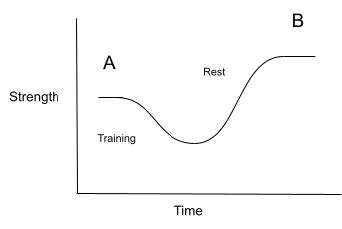
Here is a confusing statement… you do not get stronger in the gym!
I understand more than most people…the gym is awesome!!! You want to come in
every day and crush the weights and hammer the cardio. But if you are coming in every day and
pushing the intensity hard then your efforts may be counter productive. Allow me to help paint
the picture of what may be going on there.
There are four pillars to training/wellness, all of which are interconnected and equally
important. One pillar is not more important than any other but when one pillar is struggling or
lacking then that pillar will take precedence over the others until it becomes stable again.
Sometimes addressing one pillar will help support the others (hence being interconnected) so
when one is struggling that typically leads to the others falling apart as well. Here are the four
pillars but we will mainly talk about the first two here:
1. Physical
2. Recovery
3. Nutrition
4. Non-Physical
In my experience training people and providing fitness consultations, almost everyone
understands the physical pillar. They understand that being physically active is important
whether it be lifting, running, swimming, walking, gardening, yoga, tai chi, and so on. However,
many people struggle with the recovery pillar. What are you doing to give your body the chance
to actually grow from physical activity? When I ask someone that question, they typically
struggle to find an answer right away or they realize (or are reminded) that they need more
focus on physical recovery. It’s similar to knowing what a clean diet is in that everyone knows
what “healthy” food is and what “unhealthy” food is. Everyone knows you need to rest every
once in a while to not over do it. Yet there is a difference between knowing something because
you’ve been told or seen it over and over again compared to actually doing it or experiencing it
for yourself and feeling the effects first hand. Intensity has to be accompanied by appropriate
recovery and that is the bottom line. Let’s give this idea an actual visual.
Figure 1.

In figure 1 we see an illustration of the graphical curve of what happens to our
strength/fitness over a period of time that includes a cycle of training and recovery. As you can
see it is not linear in nature meaning it is not a consistent rate of progress from “A” to “B”. In
order for progress to occur we must break down the body becoming temporarily weaker before
we give it time to rest and recover toward an elevated level of strength/fitness. This cycle is then
repeated over and over again with consistency so we essentially want that curve to trend
upward more than downward. If you’re training 5+ days per week then it may be possible your
recovery is trending downward instead of upward and your efforts are making you weaker, not
stronger. So training less frequently may be the better option for true strength/fitness growth to
occur. In that case, think less is more!
Figure 2.

I’m not saying train with less intensity, just less frequency. Intensity is still necessary for
an adequate stimulus to occur (that temporary reduction in strength). Without that stimulus there
can be no real adaptation. Again, all of those pillars are equally important so you can keep the
intensity high enough to stimulate change. You can still train hard and enjoy it. Yet if we look at
figure 2 you’ll see what it looks like if we do not have enough recovery leading into the next
workout. The stimulus is present but the recovery is lacking which ultimately leads to a
decreased level in strength. You certainly do not want that to happen so give your body a
chance to recuperate.
Some people will struggle to pull back on the reins and train less to gain more. My
advice to people who feel like it’s a struggle to train less is to treat your recovery just as
seriously as the lifting. As seen in figure 1, recovery is a legitimate part of training as a whole so
why not treat it as such? Your muscles are not growing when they are being stressed, they grow
when they are relaxed and refueled. You can even take an active approach to your recovery by
going for a casual walk or doing light cardio on a machine. Another way to look at it is if you
enter a workout adequately recovered then that workout will feel tremendously better than it
would if you were working out back to back with little to no recovery. So if you like lifting a lot
then why not make your lifting better with more recovery included in your regime?
I would challenge people who work out hard 5 or more times a week to try training hard
just 3 times a week for 3 months and see how your body responds. In fact you will have the
opportunity to do just that. Sign up for Merritt Powerbuilding and challenge yourself to not only
train hard but recover hard too and see your strength sky rocket!




